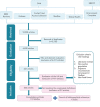Occupations at risk of contracting zoonoses of public health significance in Québec
- PMID: 33679248
- PMCID: PMC7919776
- DOI: 10.14745/ccdr.v47i01a08
Occupations at risk of contracting zoonoses of public health significance in Québec
Abstract
Introduction: Climate change plays an important role in the geographic spread of zoonotic diseases. Knowing which populations are at risk of contracting these diseases is critical to informing public health policies and practices. In Québec, 14 zoonoses have been identified as important for public health to guide the climate change adaptation efforts of decision-makers and researchers. A great deal has been learned about these diseases in recent years, but information on at-risk workplaces remains incomplete. The objective of this study is to paint a portrait of the occupations and sectors of economic activity at risk for the acquisition of these zoonoses.
Methods: A rapid review of the scientific literature was conducted. Databases on the Ovid and EBSCO research platforms were searched for articles published between 1995 and 2018, in English and French, on 14 zoonoses (campylobacteriosis, cryptosporidiosis, verocytotoxigenic Escherichia coli, giardiasis, listeriosis, salmonellosis, Eastern equine encephalitis, Lyme disease, West Nile virus, food botulism, Q fever, avian and swine influenza, rabies, hantavirus pulmonary syndrome) and occupational health. The literature search retrieved 12,558 articles and, after elimination of duplicates, 6,838 articles were evaluated based on the title and the abstract. Eligible articles had to address both concepts of the research issue (prioritized zoonoses and worker health). Of the 621 articles deemed eligible, 110 were selected following their full reading.
Results: Of the diseases under study, enteric zoonoses were the most frequently reported. Agriculture, including veterinary services, public administration services and medical and social services were the sectors most frequently identified in the literature.
Conclusion: The results of our study will support public health authorities and decision-makers in targeting those sectors and occupations that are particularly at risk for the acquisition of zoonoses. Doing so will ultimately optimize the public health practices of those responsible for the health of workers.
Keywords: occupations; public health; sectors of activity; workers; zoonoses.
Conflict of interest statement
Competing interests: None to declare.
Figures

Similar articles
-
Beyond the black stump: rapid reviews of health research issues affecting regional, rural and remote Australia.Med J Aust. 2020 Dec;213 Suppl 11:S3-S32.e1. doi: 10.5694/mja2.50881. Med J Aust. 2020. PMID: 33314144
-
Disease Risk Assessments Involving Companion Animals: an Overview for 15 Selected Pathogens Taking a European Perspective.J Comp Pathol. 2016 Jul;155(1 Suppl 1):S75-97. doi: 10.1016/j.jcpa.2015.08.003. Epub 2015 Sep 28. J Comp Pathol. 2016. PMID: 26422413 Review.
-
Examining the differences in format and characteristics of zoonotic virus surveillance data on state agency websites.J Med Internet Res. 2013 Apr 26;15(4):e90. doi: 10.2196/jmir.2487. J Med Internet Res. 2013. PMID: 23628771 Free PMC article.
-
Selected Livestock-Associated Zoonoses as a Growing Challenge for Public Health.Infect Dis Rep. 2022 Jan 13;14(1):63-81. doi: 10.3390/idr14010008. Infect Dis Rep. 2022. PMID: 35076534 Free PMC article. Review.
-
Improving occupational health surveillance for enteric infections.Zoonoses Public Health. 2024 Jun;71(4):381-391. doi: 10.1111/zph.13111. Epub 2024 Jan 9. Zoonoses Public Health. 2024. PMID: 38195823
Cited by
-
Targeted Tick-Borne Disease Recognition: Assessing Risk for Improved Public Health.Healthcare (Basel). 2024 May 10;12(10):984. doi: 10.3390/healthcare12100984. Healthcare (Basel). 2024. PMID: 38786395 Free PMC article.
-
Occupational Lyme Disease: A Systematic Review and Meta-Analysis.Diagnostics (Basel). 2022 Jan 25;12(2):296. doi: 10.3390/diagnostics12020296. Diagnostics (Basel). 2022. PMID: 35204387 Free PMC article. Review.
-
Risk Assessment Tools from the One Health Perspective: A Narrative Review.Risk Manag Healthc Policy. 2024 Apr 16;17:955-972. doi: 10.2147/RMHP.S436385. eCollection 2024. Risk Manag Healthc Policy. 2024. PMID: 38645899 Free PMC article. Review.
-
Updated assessment of occupational safety and health hazards of climate change.J Occup Environ Hyg. 2023 May-Jun;20(5-6):183-206. doi: 10.1080/15459624.2023.2205468. Epub 2023 Jun 2. J Occup Environ Hyg. 2023. PMID: 37104117 Free PMC article.
-
Optimising our response to a potential H5N1 avian influenza pandemic: preparing to protect people working at the human-animal interface.Med J Aust. 2025 Aug 4;223(3):117-119. doi: 10.5694/mja2.52664. Epub 2025 Apr 23. Med J Aust. 2025. PMID: 40265209 Free PMC article. No abstract available.
References
-
- Germain G, Simon A, Arsenault J, Baron G, Bouchard C, Chaumont D, El Allaki F, Kimpton A, Lévesque B, Massé A, Mercier M, Ogden NH, Picard I, Ravel A, Rocheleau JP, Soto J; for Quebec’s Multi-Party Observatory on Zoonoses and Adaptation to Climate Change. Quebec’s Multi-Party Observatory on Zoonoses and Adaptation to Climate Change. Can Commun Dis Rep 2019. May;45(5):143–8. 10.14745/ccdr.v45i05a05 - DOI - PMC - PubMed
-
- Institut national de santé publique du Québec et Université de Montréal. Observatoire multipartite québécois sur les zoonoses et l’adaptation aux changements climatiques. Bouchard C, Lowe AM, Simon A. Portrait des zoonoses priorisées par l’Observatoire multipartite québécois sur les zoonoses et l’adaptation aux changements climatiques en 2015. Montréal (QC): INSPQ, 2017. https://www.inspq.qc.ca/sites/default/files/publications/2290_portrait_z...
-
- Institut national de santé publique du Québec et Université de Montréal. Observatoire multipartite québécois sur les zoonoses et l’adaptation aux changements climatiques. Simon A, Aenishaenslin C, Hongoh V, Lowe, AM. Priorisation des zoonoses au Québec dans un contexte d’adaptation aux changements climatiques à l’aide d’un outil d’aide à la décision multicritère. Montréal (QC): INSPQ, 2018. https://www.inspq.qc.ca/sites/default/files/publications/2432_priorisati...
-
- Campylobacter jejuni Infections Associated With Sheep Castration in Wyoming, 2011. MMWR 2011;60(48):1654.
LinkOut - more resources
Full Text Sources
Other Literature Sources

